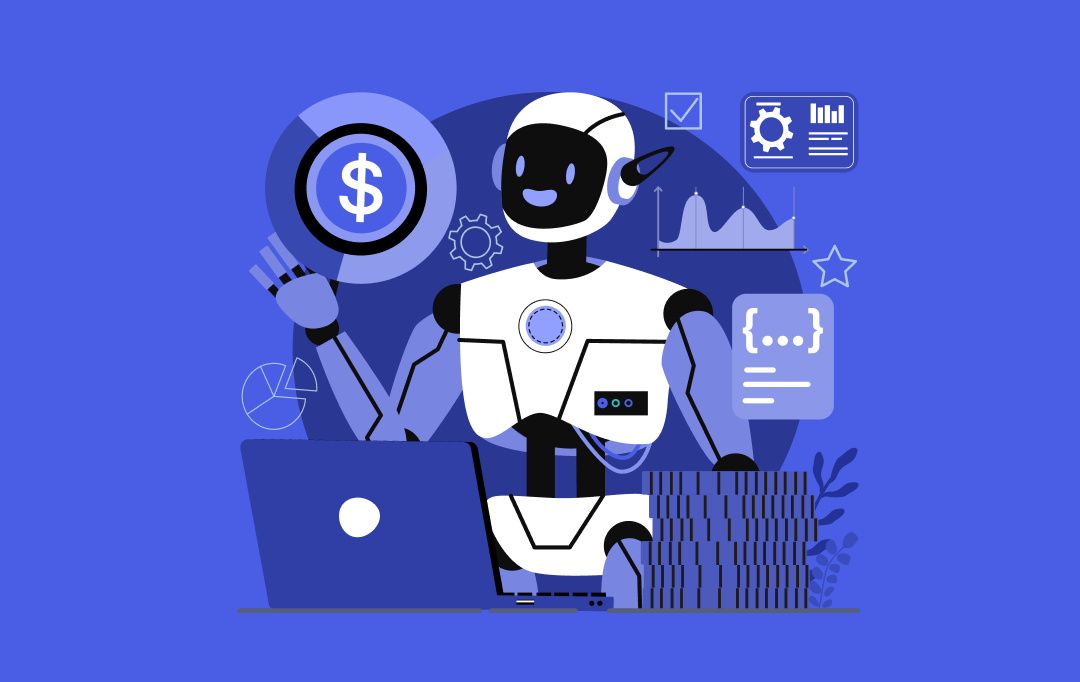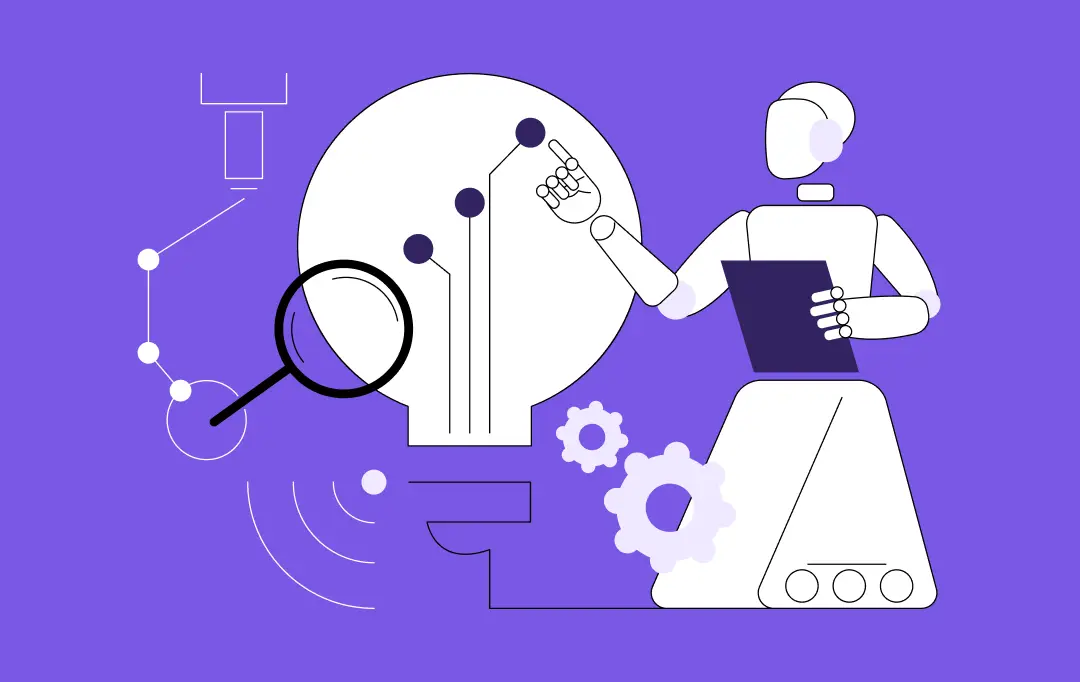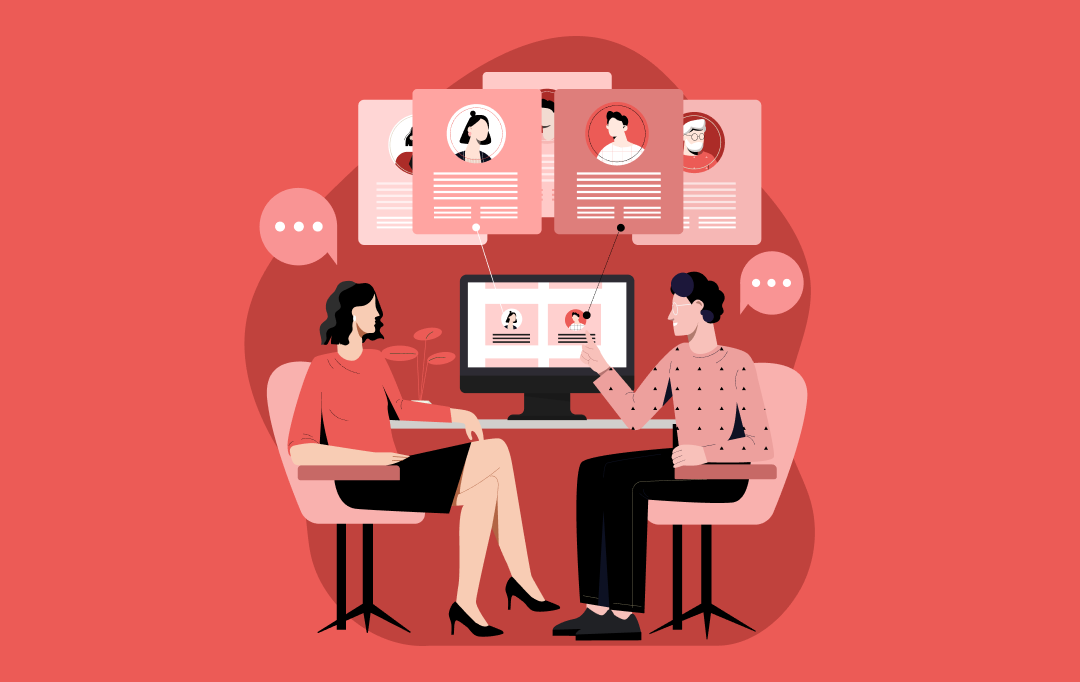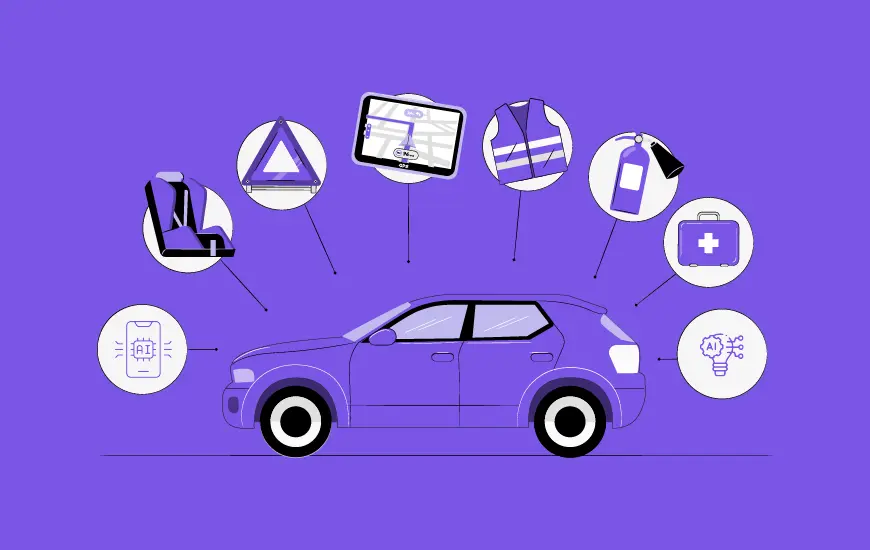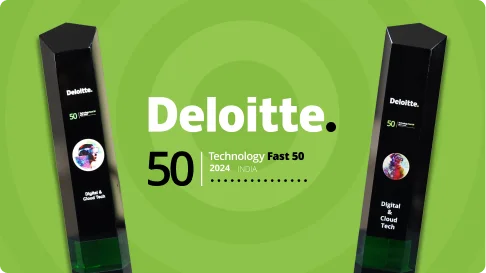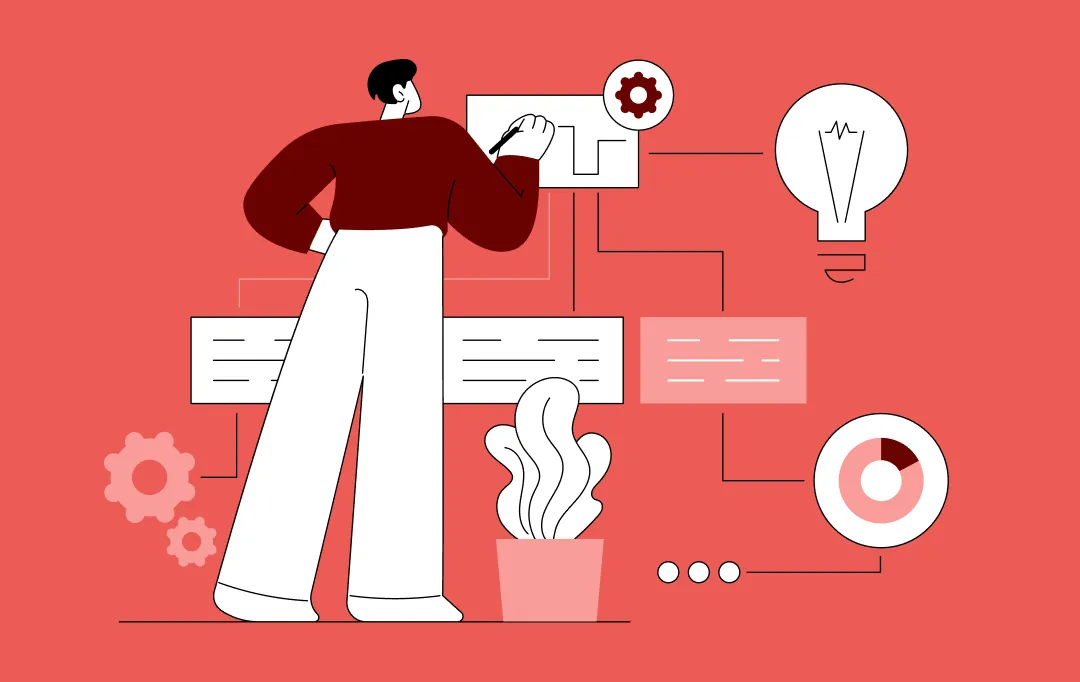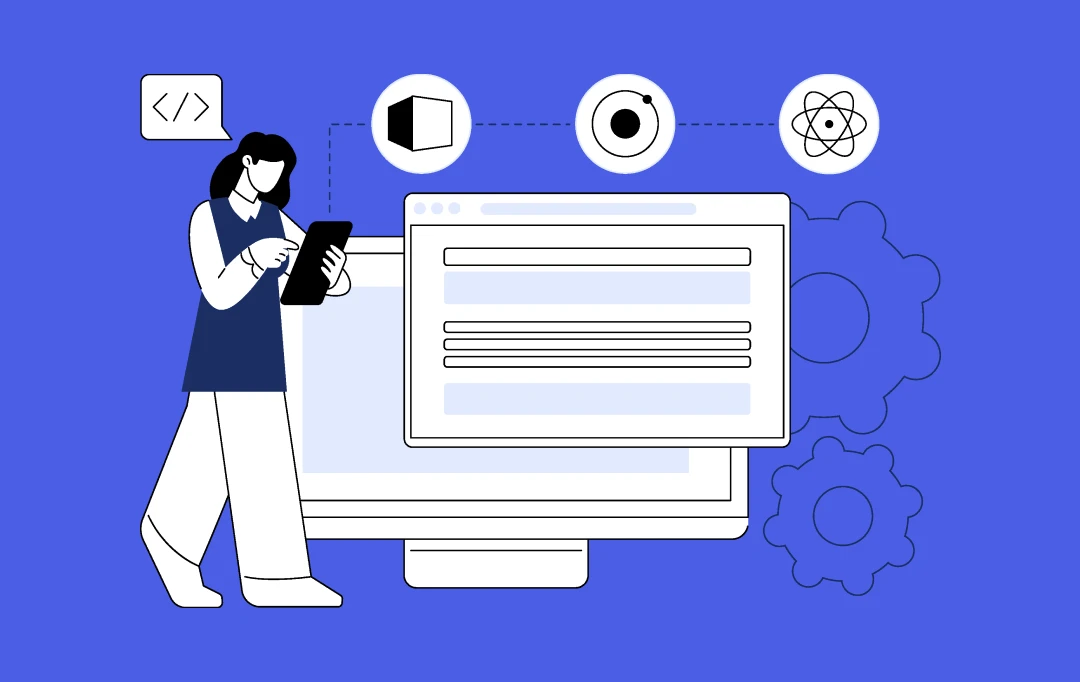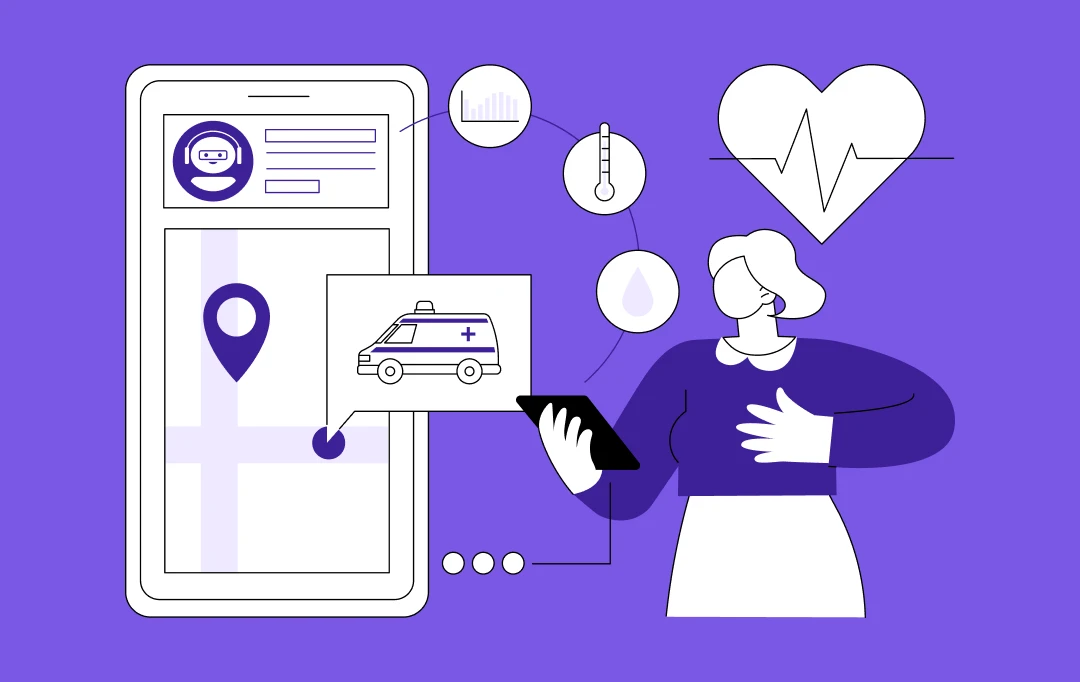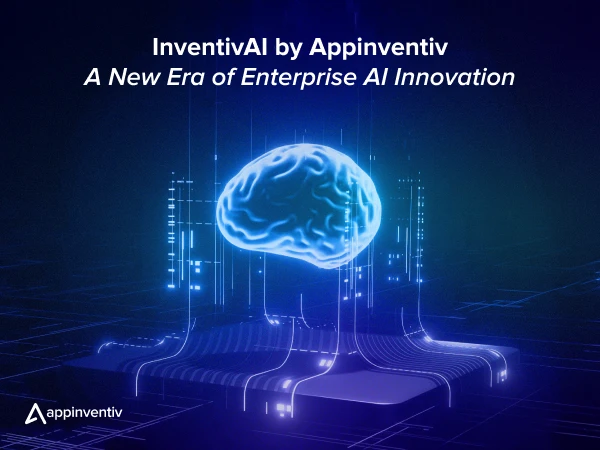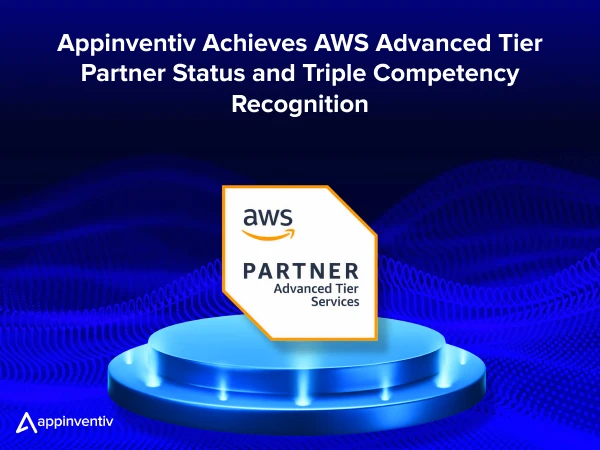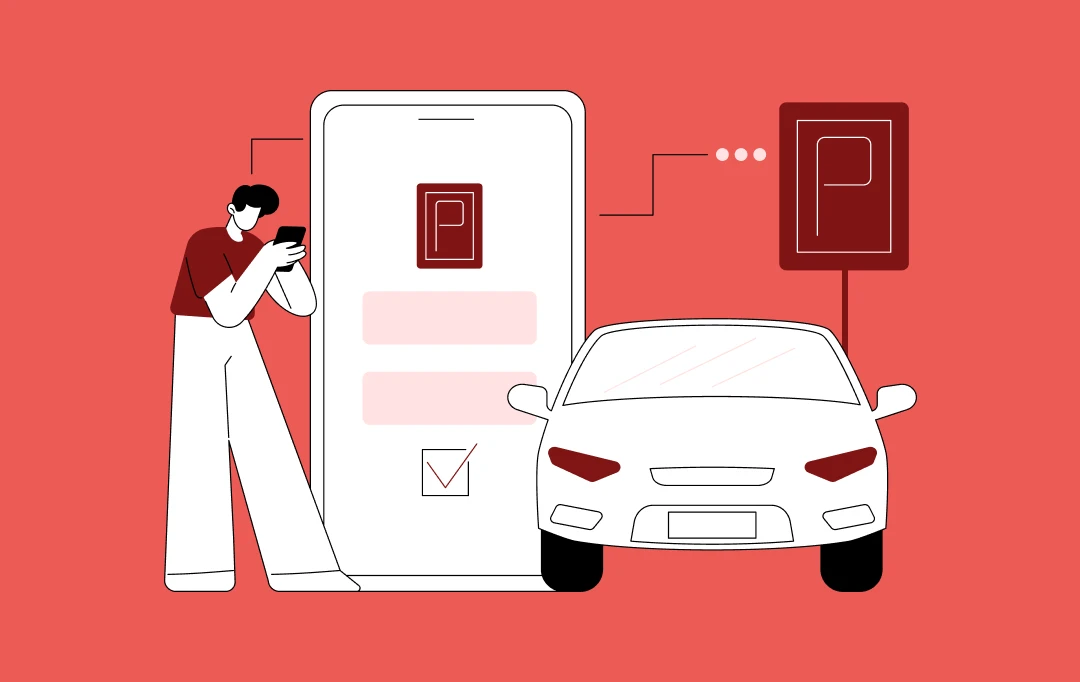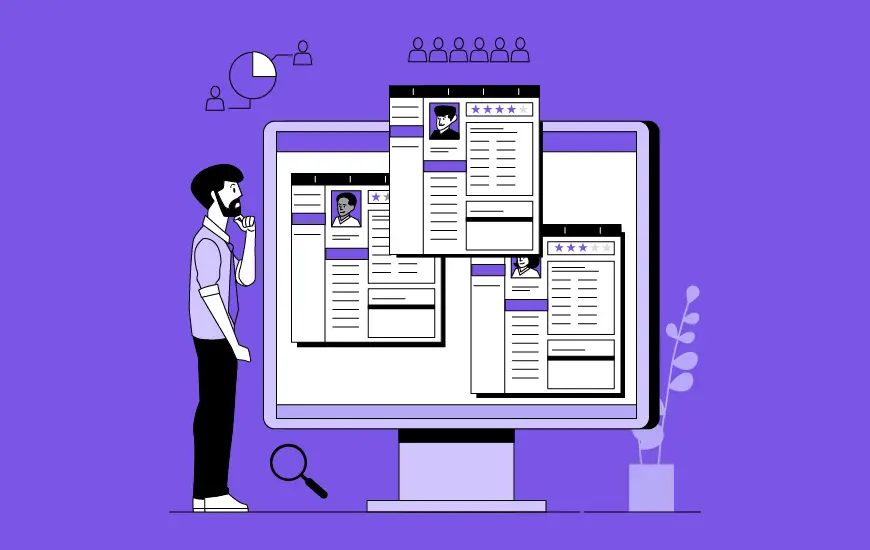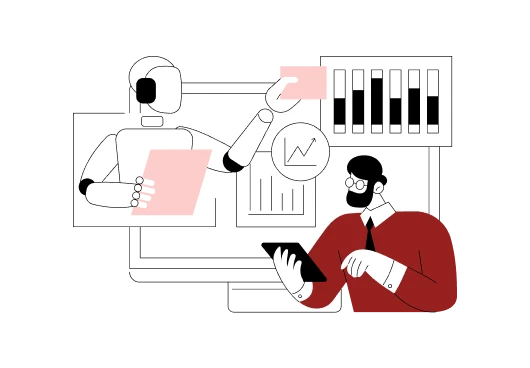- How AI Chatbots Are Transforming Australian Businesses
- Types of AI Chatbots in the Australian Market
- Rule-Based Chatbots
- AI-Powered NLP Chatbots
- Voice-Enabled Chatbots
- Domain-Specific Chatbots
- Multilingual Chatbots
- Must-Have AI Chatbot Features
- Step-By-Step Process to Build an AI Chatbot in Australia
- Step 1: Defining Use Cases and Business Objectives
- Step 2: Select the Appropriate Chatbot Type
- Step 3: Select the Tech Stack
- Step 4: Data Collection and Training
- Step 5: Building Conversation Flows
- Step 6: Constructing the Backend Architecture
- Step 7: Developing the Frontend Interface
- Step 8: Testing and Quality Assurance
- Step 9: Deployment and Monitoring
- Step 10: Maintenance and Continuous Improvement
- Factors Affecting the Cost of an AI Chatbot in Australia
- Complexity of the System
- Feature Requirements
- Integrations with Other Platforms
- Training and Data Preparation
- Voice vs Text Interaction
- Development Team Structure
- Compliance and Security Expectations
- Cost Breakdown by Chatbot Type
- Cost Based on Business Size
- Key Use Cases of AI Chatbots in Australia With Real Enterprise Examples
- 1. Customer Support Automation
- 2. Employee Support and Internal Service Desks
- 3. Retail and eCommerce Assistance
- 4. Financial Services and Advisory
- 5. Healthcare Triage and Patient Navigation
- 6. Government and Public Information Services
- Overcoming Challenges in Developing an AI Chatbot
- Data Privacy and Compliance
- Integration with Existing Systems
- Natural Language Understanding (NLU) and Local Context
- User Engagement and Retention
- Create Your AI Chatbot in Australia with Appinventiv’s Expertise
- FAQs
AI chatbots have evolved from experimental tools to everyday infrastructure for Australian businesses, transforming how customers receive information and how teams manage routine tasks. As an example, Commonwealth Bank (CommBank) launched its AI assistant called “Hey, CommBank” to allow its customers to check their balances, monitor their transactions, and receive personalised advice in real time.
This practical application depicts how chatbots may help decrease waiting time, process simple questions, and leave employees with more important things to do.
In the financial, retail, medical, and government sectors of the Australian landscape, chatbots are being deployed to automate repetitive interactions, offering real-time support, and ensuring constant interaction. They also assist companies in ensuring that they abide by the local rules through securely managing sensitive data, especially in the areas that are regulated by the Privacy Act 1988 and those that are regulated by the APRA Act.
The Australian Government AI Adoption Tracker reports that 41% of SMEs currently use AI, ranking Australia among the highest AI users worldwide. According to the AWS research, one Australian company applies AI every three minutes, but only 36% of the residents of Australia have complete confidence in AI systems, which means that it must be carefully designed and adhered to (Source: KPMG).
These trends are critical to organizations that are researching how to build an AI chatbot in Australia. In this blog, we will look into the nook and corner of this technology and how it has advanced in the Aussie landscape, types of AI chatbots, must-have features, and then moving into the main crux of how to build one. We will also cover factors affecting the costs with various cost estimation tables, key use cases and challenges.
Let’s dig deeper.
With 2 out of 5 Aussies already relying on AI chatbots, it’s time to transform your customer experience
How AI Chatbots Are Transforming Australian Businesses
The adoption of AI in Australia is continually bringing massive transformation in the region, where the use of AI chatbots is no less than an exception. Firms are not only utilizing chatbots to answer user questions, but are also utilizing them to analyse the interactions between users to generate actionable insights and promote personalised experiences. Retailers, banks, and even healthcare providers are using these insights to predict the needs of customers, make suggestions or recommendations, and even make real-time decisions.
Scalability is also possible with the integration of AI chatbots. Small and medium-sized business organizations can offer 24/7 customer interaction without adding more staff, and the bigger companies telescope large operations such as appointment booking, payment, and policy guidance. This change diminishes bottlenecks in operations and manages to make sure that corporations can cope with the increase effectively.
Moreover, chatbots in Australia are becoming more and more part of multi-channel ecosystems, including websites, applications, CRM applications, and internal company systems. This enables the companies to have continuity of service and internal teams to maintain automated workflow and knowledge retrieval.
Notably, the introduction of chatbots into the Australian environment is to be approached with the purpose of paying attention to the regulatory compliance, data privacy, and responsible AI practices. Properly implemented organizational AI chatbots can provide businesses with more than just a competitive advantage; they can also make the organization more efficient in its operations, thus making AI chatbots the engines of innovation and long-term business development.
Types of AI Chatbots in the Australian Market
Australian organizations use several kinds of conversational systems. The choice usually comes down to how complicated the service is, what compliance rules they have to follow, and just how much automation they want to put in place when they build an AI chatbot.
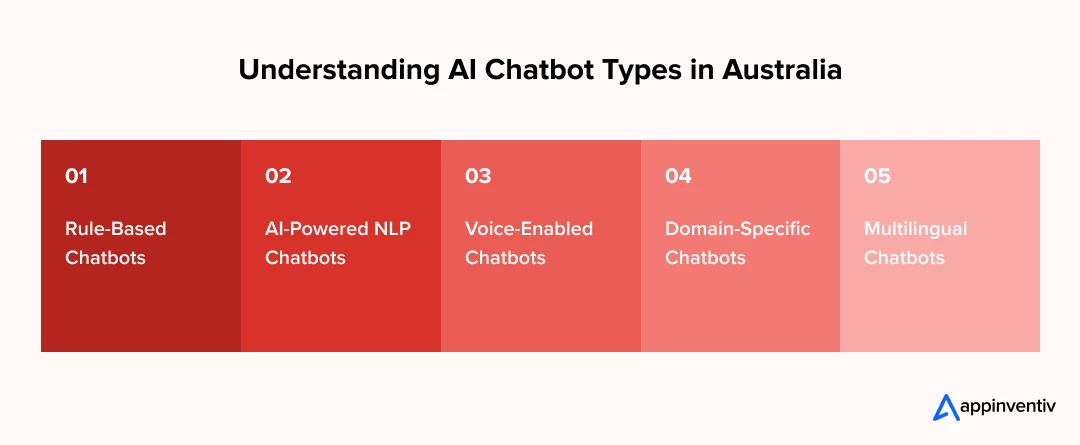
Rule-Based Chatbots
These systems just follow set logic. They basically match what the user types to a library of structured rules and then pick a response from a fixed list. They’re strong because they are predictable, good for answering common questions, checking orders, or handling those easy, first-level support jobs.
If someone is looking at how to build a chatbot from scratch, they often start here. It’s the best way to see how to keep a conversation flow organized.
AI-Powered NLP Chatbots
The AI-powered NLP assistants utilize machine learning algorithms. They can actually understand the phrasing, tone, and what the person is trying to say. Modern systems, like those based on GPT, can retain context from earlier messages.
They help support teams big time by answering questions more accurately, picking up on sentiment, and offering clearer explanations to guide users. A good chatbot developer can tweak these systems to use industry-specific terminology and reflect what Australian customers expect.
Voice-Enabled Chatbots
More and more contact centres are using voice interfaces. It reduces wait times and makes routing calls easier. These tools listen to the speech, figure out the intent, and give out answers without needing a human operator.
In Australia, the trick is training the models on local accents and regional phrases. That way, callers are understood the first time, not after repeating themselves a bunch.
Domain-Specific Chatbots
Some industries just have specific compliance stuff they need to worry about. For example, healthcare assistants need to align with the Australian Privacy Principles, the My Health Records Act, and the security standards set by APRA CPS 234.
You have retail bots that handle inventory and order updates, and education systems that help with enrolment and student questions. Each of these variants is really just a reflection of the workflows and policy requirements of its own field.
Multilingual Chatbots
Having good language coverage is a really practical need in a multicultural place like Australia. Lots of organizations are adding Mandarin, Arabic, Vietnamese, and other community languages to make things easier for everyone.
It’s a straightforward way for businesses to reach bigger audiences and take the headache out of the process for new customers.
Must-Have AI Chatbot Features
If you are planning how to build an AI chatbot in Australia, the first step is to understand the features that shape a reliable and compliant system.
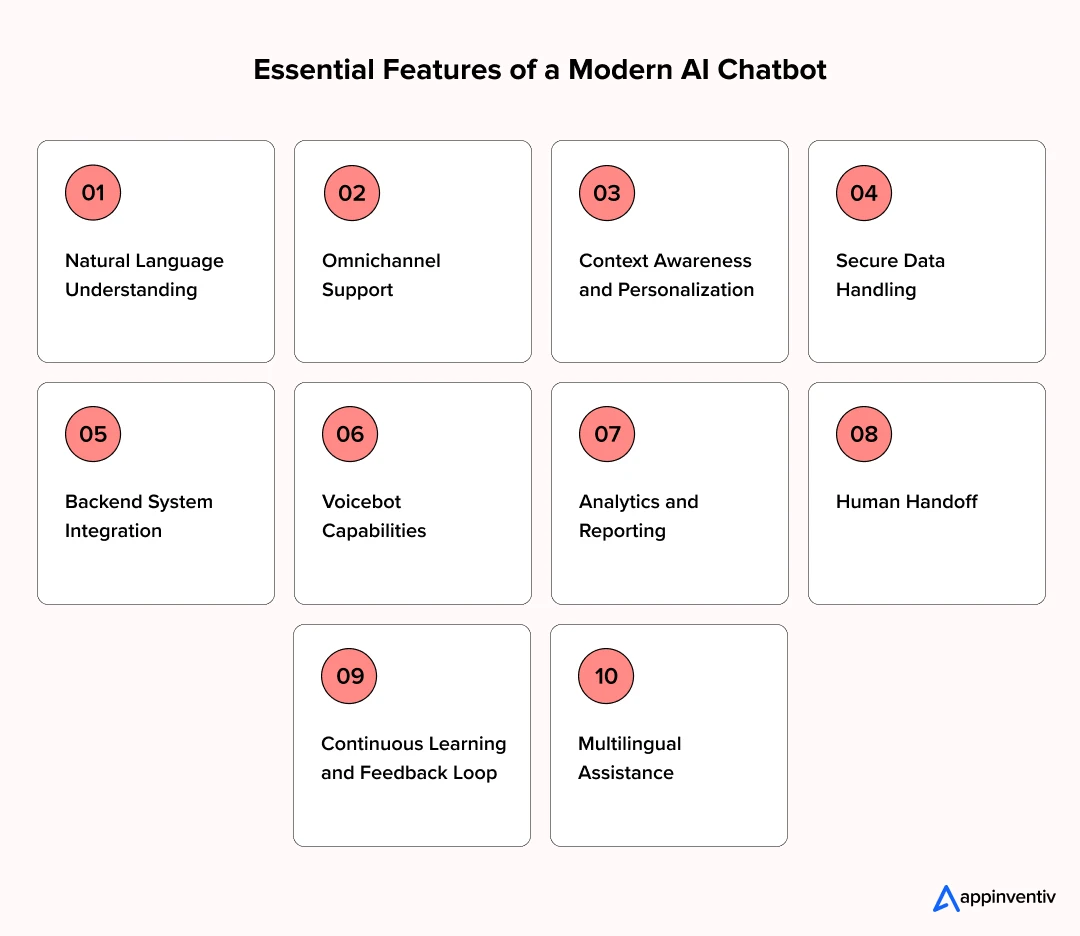
Natural Language Understanding: The model is supposed to comprehend Australian English in a nonchalant manner. It must be aware of the local spelling and other conversational words to ensure responses are easily understood and correct.
Omnichannel Support: A contemporary assistant is expected to be visible in the entire website, mobile application, WhatsApp, Messenger, and other social platforms. Constant performance on these touchpoints is a significant aspect of a seamless customer service experience during AI chatbot development.
Context Awareness and Personalization: An intelligent chatbot can utilize the previous interactions, browsing patterns, and CRM data to offer solutions that are relevant to the case of the user. This lessens the repetition and causes faster results.
Secure Data Handling: In order to build a secure app in Australia, every data practice should be in compliance with the Australian Privacy Act and guidance from the Office of the Australian Information Commissioner. A large number of organizations use AWS, Azure, or Google Cloud zones in Australia where they store sensitive information.
Backend System Integration: The assistant needs to be connected to CRM applications such as Salesforce or Zoho, read ERP records, and integrate with payment gateways where necessary. These attachments transform the chatbot into effective service technology rather than a primitive help desk.
Voicebot Capabilities: Phone support requires an accurate speech-to-text performance. Trained models with Australian accents better handle callers and are less misunderstood.
Analytics and Reporting: The use of clear reporting tools helps teams analyze conversation patterns, resolution rates, and common pain points. This fact informs the continuous refinements when they develop an AI chatbot in Australia.
Human Handoff: Once the bot becomes inactive, it is necessary to redirect the conversation to a live agent without the loss of any context. This prevents frustration and reduces the support time.
Continuous Learning and Feedback Loop: Conversation ratings, monitored reviews, and frequent updates facilitate the improvement of the model to keep it in line with actual user behavior.
Multilingual Assistance: Other organizations include languages like Mandarin or Arabic, or Vietnamese in an effort to accommodate various groups of people in Australia.
Step-By-Step Process to Build an AI Chatbot in Australia
Any attempt to build an AI chatbot in Australia requires a well-planned strategy when you start thinking about it. Almost all technical decisions you undertake are strongly affected by the local expectations regarding privacy, cloud security, and the ethics of responsible AI development. Thus, a step-by-step approach is usually the most intelligent way to work.
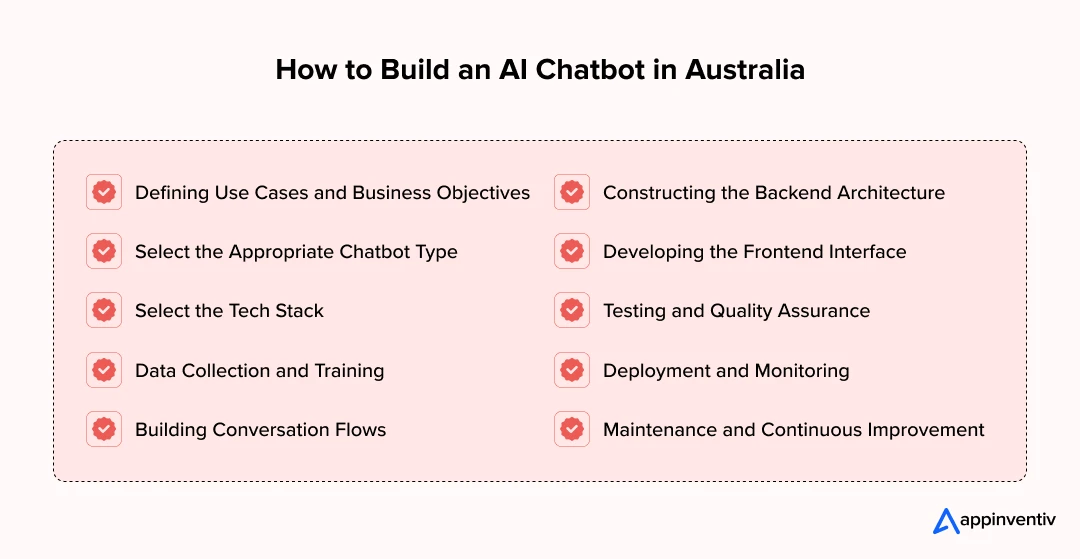
Step 1: Defining Use Cases and Business Objectives
The very first step in the AI chatbot development process in Australia is to begin with clearly explaining the chatbot’s target. Teams that seek automation to answer frequent questions are customer care divisions; the other departments, sales teams, may seek guided conversations to simply obtain lead qualification.
Other organizations go as far as to implement AI internally to assist employees in searching through the knowledge bases of their companies. In case the chatbot handles sensitive or regulated data, you should initially consider the Australian Privacy Principles and any national requirements that are related to the digital transformation program, since these will influence the design on day one.
Step 2: Select the Appropriate Chatbot Type
You should choose the kind of system that best fits your scope of the project. A bot with rules is suitable for the predictable, repetitive work. With an NLP-based bot, the sentence patterns are comprehended, and it is therefore far superior in open-ended interactions with the service.
Voicebots are useful in cases when hands-free is needed. The GPT-based assistants are the solution to maximum flexibility and natural and extended dialogue.
Step 3: Select the Tech Stack
Select the tools that suit the extent and nature of your chatbot. Open AI models are commonly used in many teams for natural dialogue and summarisation tasks, whereas Google Dialogflow CX is typically applied to structured and multi-step flows.
Amazon Lex is better suited to use voice and text automation in AWS, and Rasa should be used when it is necessary to have complete control over the training data and on-premise deployment. In the case of orchestration, LangChain assists in connecting big language models to outside tools, custom reasoning, and retrieval frameworks.
In cases where the chatbot requires stable memory or long-term context, the embeddings under a vector database like Pinecone, Weaviate, or Chroma can be embedded, and a fast semantic search may be performed.
Step 4: Data Collection and Training
The foundation involves collecting domain materials that accurately reflect authentic user language. The data collection processes incorporate support transcripts and technical industry terms, ensuring capture of regional vocabulary, necessary tone, and spelling.
Handling all personal information requires absolute adherence to the Privacy Act 1988 and any specific sector requirements. Especially in regulated areas like health or finance, businesses must enforce rigorous validation before training begins.
Step 5: Building Conversation Flows
Define the precise conversational pathways before starting any build. The objective is to establish how the chatbot guides a user effectively from their initial request toward a satisfactory final resolution.
Detail common intents, necessary follow-up queries, and specific fallback routes that provide immediate, clear clarification during misunderstandings. These mapped flows are critical in preparing the system for diverse interactions, offering reviewers a practical, predictive view of the chatbot’s behavior across all conditions.
Step 6: Constructing the Backend Architecture
Thorough preparation of the supporting infrastructure is paramount. This encompasses the database for storing user preferences and chat transcripts, the required API layer for business system integration, and the governing logic managing authentication protocols and defined rate limits.
Hosting the system within Australian cloud zones greatly helps optimize performance and meet all mandatory compliance requirements for secure data storage. A reliable backend is essential for sustaining scalability when platform engagement ultimately increases.
Step 7: Developing the Frontend Interface
The interface design must prioritize three factors: clarity, usability, and complete accessibility. Compliance with WCAG guidelines is standard practice, as these are broadly adopted across Australian government and enterprise systems.
Ensure the layout remains clean, input fields are intuitive to navigate, and the chat window operates consistently across both mobile and desktop formats. A well-designed interface is key to generating user trust and encouraging sustained, regular interaction.
Step 8: Testing and Quality Assurance
Execution of detailed, staged testing is a requirement. Verification of NLU accuracy must use a comprehensive local phrase set. Rigorous load tests need to accurately simulate the anticipated peak traffic volumes.
If speech input is a feature, testing must include varied Australian accents and natural speech patterns. Furthermore, security settings demand extensive validation, particularly in regulated industries where national authorities routinely review responsible AI conduct and privacy safeguards.
Step 9: Deployment and Monitoring
Utilize established CI/CD practices to ensure the secure release of all updates. Configure monitoring dashboards to track crucial metrics, including latency, error rates, and comprehensive user behavior.
Implementing auto-scaling within local cloud regions ensures the system adjusts capacity smoothly during unexpected traffic surges. Detailed logging is also necessary at this stage; it provides the auditable record needed to audit and refine the chatbot as usage expands.
Step 10: Maintenance and Continuous Improvement
Post-launch, consistently review transcripts and analytics to identify exact performance gaps. Retrain the model using the latest conversational examples, systematically expand the range of recognized intents, and introduce AI chatbot features based on explicit user requests over time.
These routine updates ensure the AI chatbot remains accurate, completely reliable, and continuously aligned with the operational expectations of both the user base and official regulatory bodies.
Also Read: AI App Development in Australia – Features, Costs, Process
Factors Affecting the Cost of an AI Chatbot in Australia
The cost to make an AI chatbot in Australia falls under the range of AUD 40,000 to AUD 400,000 ($30,000 to $300,000) or more, depending on a number of factors, as several regional considerations influence the final investment. The country’s regulatory scene, local rules on digital service, and specific delivery practices all shape the overall path for development and exactly how many resources are needed. Let’s have a look at it.
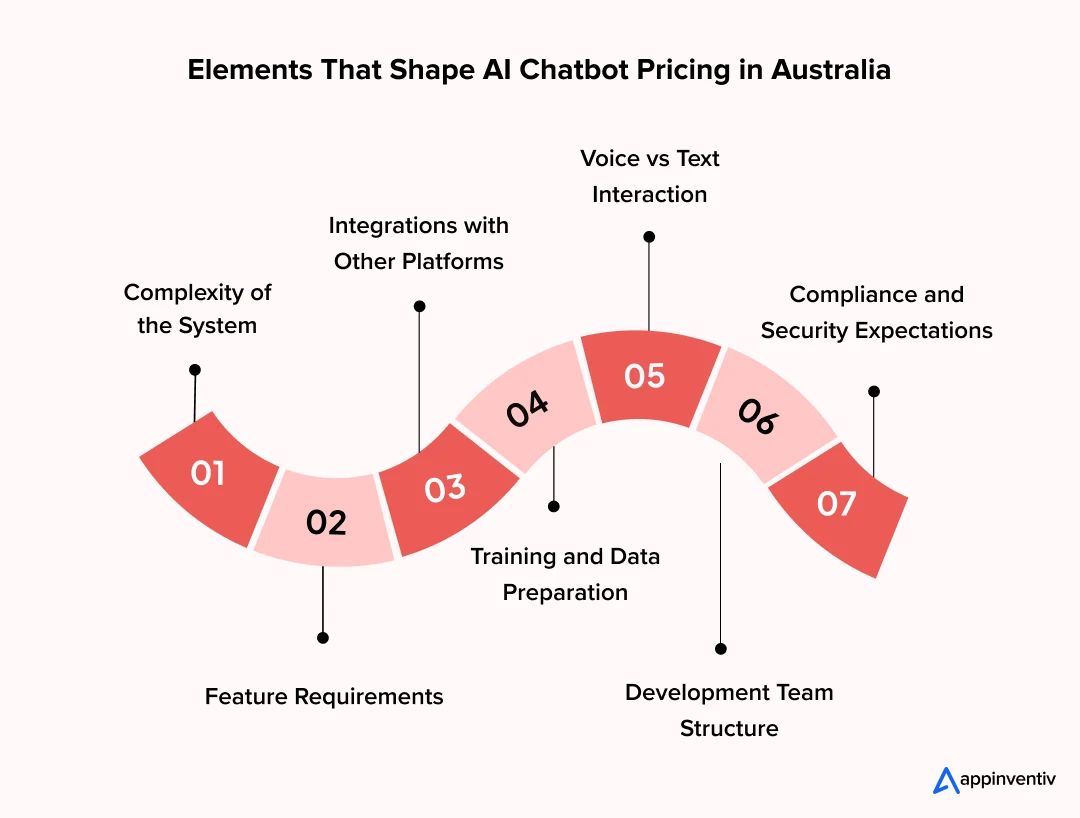
Complexity of the System
Chatbots that are more advanced demand more engineering. In Australia, it is commonly the support of sector frameworks like the Digital Service Standard for government-facing tools, or industry compliance inspections of finance, healthcare, and insurance.
These standards have an impact on the design and review of conversation flows, adding more development work to the process, thus influencing the overall costs.
Feature Requirements
When a project has secure authentication, audit logging, enterprise analytics, or multi-department workflow, it increases the costs. Role-based access controls, documented consent workflows, and integration with secure identity providers like Azure AD or GovID are also features that Australian organizations operating in a regulated setting are expected to need. These extra layers increase the development cycle, thus impacting the costs.
Also Read: Appinventiv joins Australian Gov’s Digital Marketplace
Integrations with Other Platforms
Most systems of local businesses are often hosted in Australian data centres or on controlled networks. The use of chatbots in combination with these systems can be accompanied by stringent API management, controlled access zones, and thorough security assessment procedures.
This is especially true for industries that are regulated by APRA or state health regulations, or internal IT governance practices.
Training and Data Preparation
The Australian privacy requirements should apply to projects involving proprietary or sensitive data. Information should be examined, de-identified where necessary, and archived in accordance with local residency guidelines in case the organization is bound to sector regulations.
The preparation phase may be essential in cases of health, government, and financial service deployments that are subject to the Privacy Act or the Australian Government Information Security Manual (ISM).
Voice vs Text Interaction
The voice interfaces are usually subject to stricter compliance inspections, particularly when recordings are subject to data retention or call-recording regulations in the finance, telecommunications, and insurance sectors.
Accessibility requirements of the Australian disability-access standards also require voice solutions to meet the requirements, and this contributes to the time spent in design and testing.
Development Team Structure
In Australian development teams, the overall delivery models are usually structured and have discovery phases, technical governance reviews, and compliance checkpoints. Onshore teams are also likely to engage qualified security experts in cases where the projects involve secured data.
Such practices are more reliable and less risky, but also add to the cost of the project as compared to less formal offshore delivery models.
Compliance and Security Expectations
Many Australian organizations operate under formal regulatory frameworks, and these obligations have a direct impact on chatbot development costs. The more stringent security approach is needed on projects that are covered under the Privacy Act 1988, the Australian Government Information Security Manual, APRA CPS 234, or state health information regulations.
Each requirement increases engineering effort, governance reviews, and specialised security effort, all of which increase the overall investment required to provide a solution that meets all compliance requirements.
Cost Breakdown by Chatbot Type
A typical AI chatbot development cost in Australia falls within the following ranges, depending on the type of system and the expected level of intelligence. Refer to this table below to know more about the overall costs.
| Chatbot Type | Estimated Cost (AUD) | Reference Range (USD) | Notes |
|---|---|---|---|
| Rule-Based Chatbot | 40,000 to 80,000 | (30,000 to 50,000) | Operates on predefined flows and structured decision paths. |
| NLP-Based Chatbot | 80,000 to 150,000 | (40,000 to 120,000) | Understands natural language and supports flexible conversation patterns. |
| Advanced AI Chatbot (GPT-powered) | 150,000 to 400,000+ | (70,000 to 300,000) | Provides advanced reasoning and custom-data training with orchestration layers. |
| Voicebot | 120,000 to 400,000+ | (90,000 to 350,000+) | Includes speech recognition, voice synthesis, and specialized audio testing. |
Higher figures usually apply when the deployments demand support for regulated workloads, multi-platform rollout, or particularly complex integration pathways.
Cost Based on Business Size
The overall cost changes significantly with organizational scale; the required breadth of automation influences investment heavily.
| Business Size | Typical Scope | Estimated Investment |
|---|---|---|
| Small Businesses | Basic automation only, featuring minimal systems integration. | Lower range of rule-based or entry-level NLP systems. |
| Medium Enterprises | Multi-channel deployment with essential CRM or ERP links. | Mid to upper range of NLP solutions. |
| Large Enterprises | High-end AI involving comprehensive compliance reviews and custom datasets. | Upper range of GPT systems or voicebots. |
Industries that must meet strict oversight frameworks always demand extended test cycles, detailed documentation, and formal audits, factors that inevitably raise the overall investment requirement.
Key Use Cases of AI Chatbots in Australia With Real Enterprise Examples
AI chatbots are demonstrably changing how Australian organizations handle customer relations, streamline staff workflows, and ultimately deliver services with greater efficiency. The following items detail the most impactful use cases, supported by specific real-life enterprise examples.
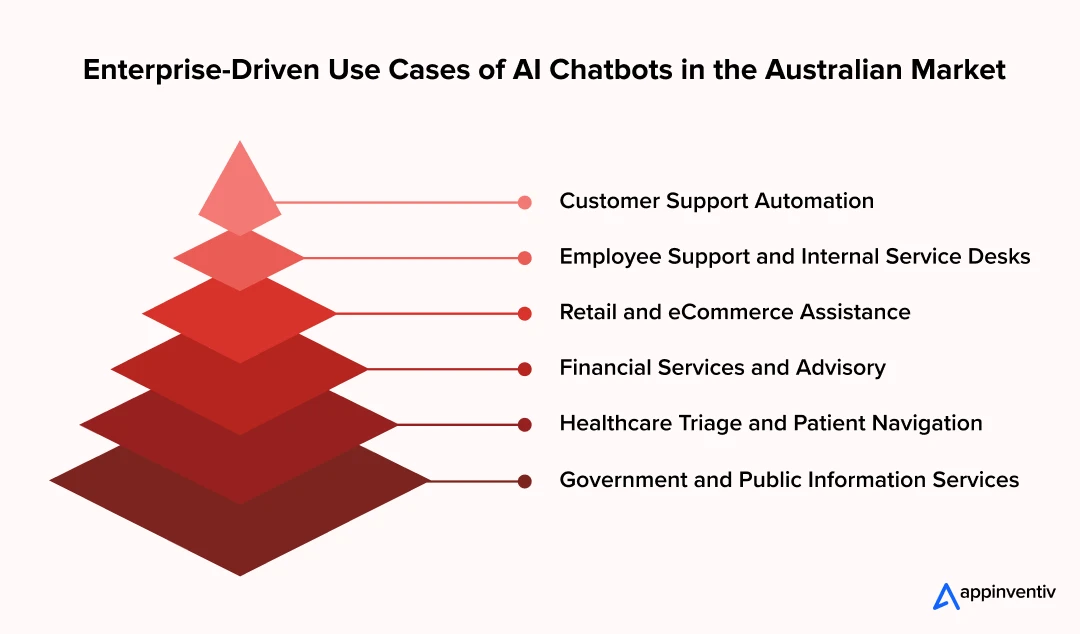
1. Customer Support Automation
These bots assist organizations in handling huge volumes of customer queries. This reduces the time people have to wait and ensures consistent answers are provided across all channels. They handle routine issues, billing questions, and product guidance effectively. This stands as one of the most common use cases of an AI chatbot in Australia.
Example: Commonwealth Bank uses its AI assistant, Ceba, to quickly answer everyday banking questions and provide instant support. This simple measure frees staff to concentrate on more complex tasks, illustrating effective planning for how to build an AI chatbot in Australia.
2. Employee Support and Internal Service Desks
Another important benefit of AI chatbot development is that xhatbots, internally, are excellent for streamlining workflows. They manage IT requests, HR questions, and new staff onboarding tasks. Resolution times are shorter, and teams receive consistent guidance, regardless of their size.
Example: The internal assistant at CBA helps resolve IT issues and guides staff through common processes, which directly improves productivity. Systems like this are often cited as practical AI chatbot examples in large enterprise deployments.
3. Retail and eCommerce Assistance
Retailers find chatbots assist significantly with product discovery, order tracking, and returns. Simultaneously, they deliver personalised recommendations. These systems improve the customer experience and, importantly, reduce the effort required from manual support staff.
Example: Woolworths uses an AI-driven assistant specifically for order and delivery queries. This helps customers rapidly access necessary information, showing how companies can develop an AI chatbot in Australia for operational efficiency.
4. Financial Services and Advisory
AI chatbots help banks provide crucial account insights, personalised financial guidance, and market updates, all while maintaining regulatory compliance. They enhance client engagement and reduce the necessary response times.
Example: ANZ’s multi-agent chatbot, Amie, helps institutional bankers interpret complex market data and generate client-ready reports with far greater efficiency. This is a powerful example among modern AI chatbot examples in financial services.
5. Healthcare Triage and Patient Navigation
With the greater adoption of AI in Australian healthcare, medical operations have become highly automated and streamlined. Chatbots support appointment scheduling, offer symptom guidance, and handle patient follow-ups. This greatly improves patient access to care and lessens the administrative burden. They prove particularly valuable in high-volume clinics and telehealth services.
Example: Queensland Health employs online triage bots. These guide patients toward appropriate care pathways, a key move that lowers pressure on existing hospital staff. This demonstrates practical steps to develop an AI chatbot in Australia in sensitive sectors.
6. Government and Public Information Services
Government agencies use chatbots to deliver instant guidance on permits, licences, and various public programs. This improves accessibility for citizens and increases operational efficiency for the agency.
Example: Service NSW uses virtual assistants to handle licence renewals and grants enquiries, providing clear, timely information to the public. This reflects key learnings on how to build an AI chatbot in Australia for public-facing services.
Implement AI chatbots in your organization to personalize user experiences and stay ahead in a competitive Australian market
Overcoming Challenges in Developing an AI Chatbot
Building AI chatbots is certainly transformative. But it consistently comes with its own distinct set of challenges. Understanding these issues, then applying practical, specific solutions, is absolutely critical for successful deployment. This is especially true within Australia’s regulated industries.

Data Privacy and Compliance
Challenge: Dealing with sensitive customer or employee data can be genuinely complex. This requires strict adherence to Australian privacy laws like the Privacy Act 1988, plus APRA guidelines and various state health regulations.
Solution: Implement role-based access controls first. Encryption of data is essential, both when being used (in transit) and when stored (at rest). Hosting data in Australian cloud zones, plus running regular audits, finalizes the compliance checks.
Integration with Existing Systems
Challenge: Australian enterprises frequently run on a mix of older legacy systems, existing ERP platforms, and secured network environments. Getting a new chatbot to integrate without disrupting established workflows remains difficult.
Solution: The technical requirement involves using modular APIs, middleware, and a microservices architecture. Conduct staged integration testing afterward. This ensures smooth, reliable data flow between the chatbot and all existing platforms.
Natural Language Understanding (NLU) and Local Context
Challenge: Generic models often struggle when a chatbot must understand Australian English, local slang, and specific industry vocabulary. This challenge is common.
Solution: Training the models must utilize local datasets. You need to include specialized, domain-specific intent recognition. Finally, continuously monitoring the system’s performance will steadily boost understanding over time.
User Engagement and Retention
Challenge: Users will walk away if the interaction with your chatbot feels too robotic, or worse, if it proves unhelpful.
Solution: Design conversation flows that are genuinely natural and adaptive. Incorporate clear fallback mechanisms to human agents. Then, consider using reward-based engagement strategies to maintain user interest.
Create Your AI Chatbot in Australia with Appinventiv’s Expertise
AI chatbots are redefining how businesses operate. They manage customer engagement, support employees, and deliver services efficiently. Across Australia, organizations from banking and healthcare to retail and government are using conversational AI. This streamlines workflows, improves engagement, and helps maintain compliance with all local regulations.
Our experience across diverse industries demonstrates this practical impact of AI chatbots. Our teams have consistently seen how effective and well-planned chatbot solutions can fundamentally change the way various organizations operate. Here are a few examples showing the depth and variety of our work in conversational AI:
Mudra (FinTech): We helped them design and shape a conversational assistant specifically targeted at young users. The goal was simple: introduce personal finance concepts in an easy, nearly game-like format. That product ended up being a huge success and was later expanded into over a dozen different countries.
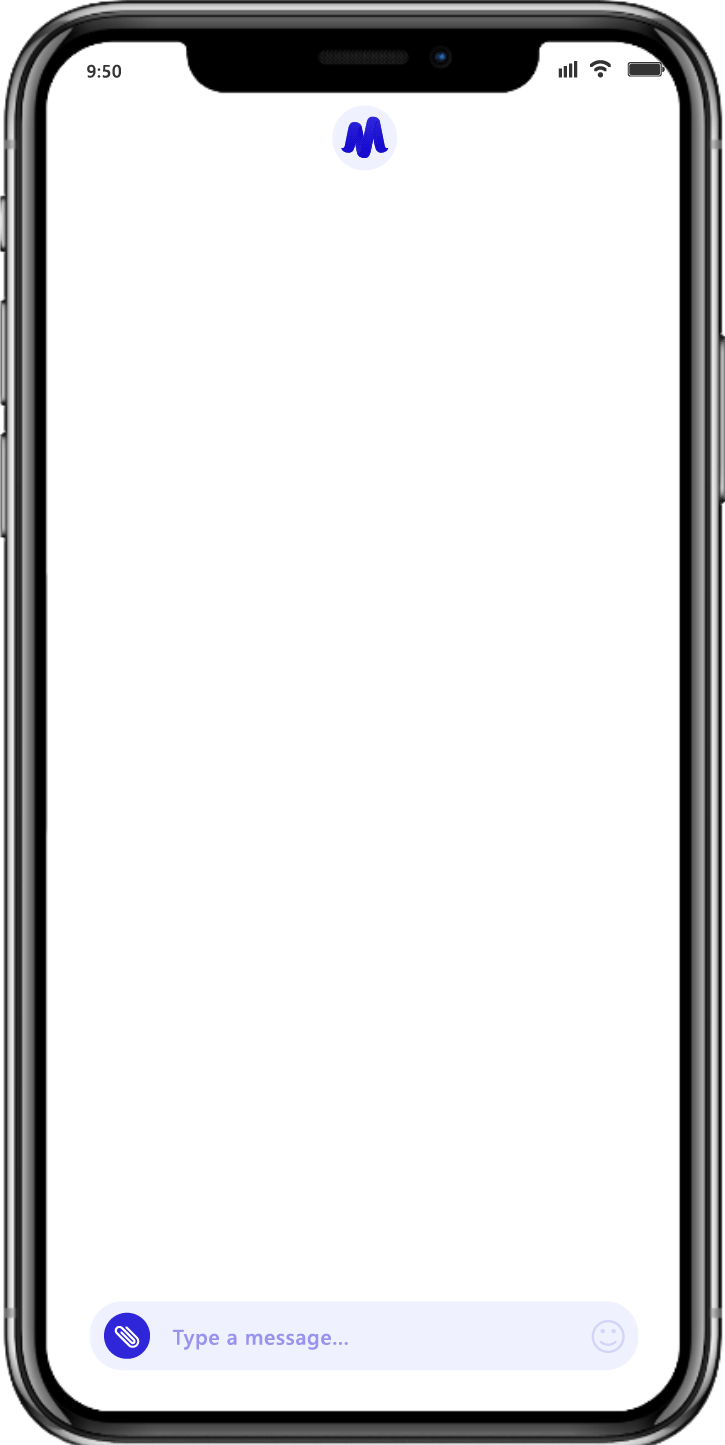
Vyrb (Wearables/Social Audio): For Vyrb, we supported the development of their core voice-driven interaction model. We worked to bring clarity and structure to how people use social audio on wearable devices. The success and strength of this unique approach really helped the company secure significant early-stage funding.
Flynas (Airline): Flynas utilized our expertise to refine its entire booking and customer service workflow using an AI-supported chat platform. This intervention smoothed out customer journeys, which, in turn, strengthened repeat engagement and loyalty.
MyExec (Business Intelligence): We built a multi-agent chatbot system that handled the translation of long, dense business documents. The bot’s purpose was to convert that information into direct, usable, and simple guidance. This gave small teams much faster access to critical information and ultimately lowered the cost associated with day-to-day decision-making.
For organizations aiming to stay ahead in the Australian market, partnering with Appinventiv for artificial intelligence development services in Australia ensures a completely tailored approach. Our expertise helps businesses design, develop, and deploy AI chatbots.
These align with strategic objectives. They maintain regulatory compliance. And they deliver truly measurable results. With Appinventiv, you can transform customer interactions, streamline operations, and unlock new opportunities through conversational AI solutions.
FAQs
Q. How to build an AI chatbot in Australia?
A. Building an AI chatbot in Australia always starts with understanding your specific business goals. What problems, exactly, are you solving? You must select the right AI technology stack. You need to prepare the correct datasets.
And you have to design conversation flows that genuinely feel natural to the users. Working with experienced developers such as Appinventiv helps handle compliance with Australian regulations. That also ensures the bot performs reliably right from day one.
Q. How much does it cost to build an AI chatbot?
A. The cost of an AI chatbot in Australia varies significantly as it mainly depends on features, complexity, integrations, and whether it’s primarily text or voice-based. In Australia, you can expect a range starting around AUD 40,000 for basic rule-based bots. This range extends right up to AUD 400,000+ for advanced, GPT-powered solutions. Training custom datasets or integrating with multiple enterprise systems are factors that strongly influence the final investment figure.
Q. Why should Australian businesses invest in AI chatbots?
A. AI chatbots help businesses save time. They reduce operational costs. They provide customers with instant support 24/7. They prove especially useful for industries with heavy compliance needs: banking, healthcare, and government services, for instance. They can handle routine queries while ensuring data privacy and proper security.
Q. How long does it take to develop an AI chatbot?
A. Development timelines depend entirely on the chatbot’s complexity. Simple rule-based bots can often be ready in 4–6 weeks. NLP-enabled chatbots, however, may take a bit longer, maybe 2–3 months. Enterprise-grade AI chatbots, featuring advanced capabilities like multi-agent support or voice interaction, may require 4–6 months to fully develop and deploy.
Q. Can AI chatbots integrate with existing systems?
A. Absolutely. AI chatbots easily connect with your existing CRM, ERP, databases, or other platforms. This is done securely using APIs and middleware. Proper integration ensures smooth data flow. It enhances automation. And it allows your chatbot to become a fully functional part of your business ecosystem.
Q. Do AI chatbots require ongoing maintenance?
A. Yes, they definitely do. Chatbots require regular updates, retraining sessions, performance monitoring, and security checks to maintain effectiveness. When you develop an AI chatbot in Australia with Appinventiv, we provide continuous support. That ensures your bot keeps delivering accurate, reliable, and engaging interactions over time.


- In just 2 mins you will get a response
- Your idea is 100% protected by our Non Disclosure Agreement.
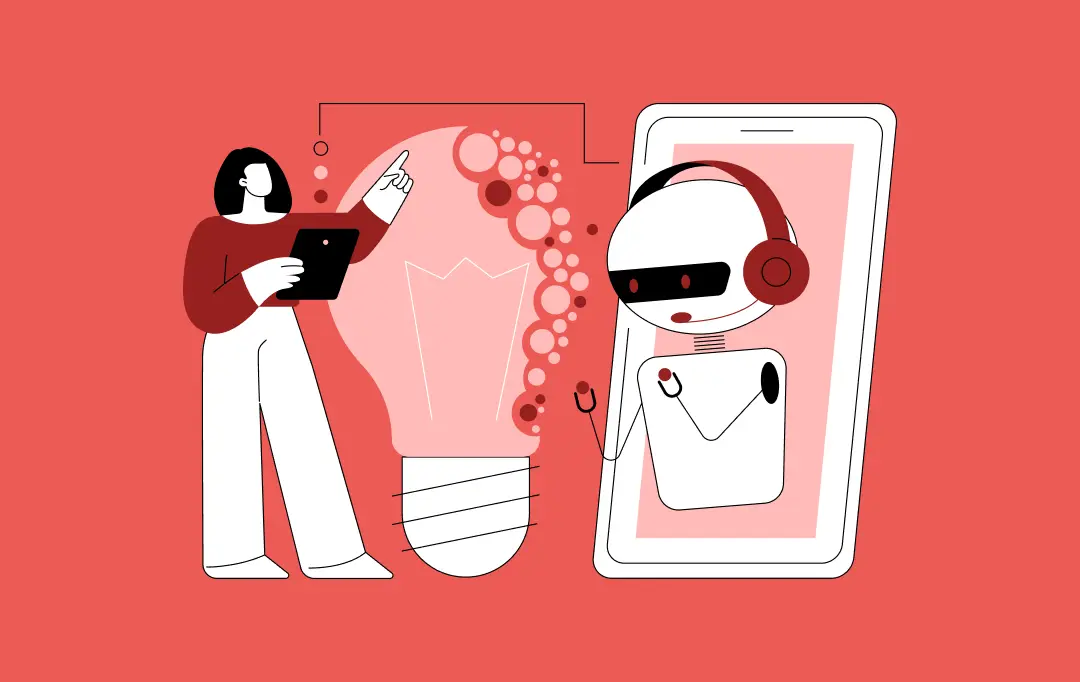
How Much Does It Cost to Build an AI App in Dubai?
Key takeaways: AI app costs in Dubai typically range from AED 80,000 for simple builds to AED 800,000+ for enterprise systems. Dubai is past AI experimentation, and not investing now means catching up later at higher cost. The real budget is driven by data, integrations, architecture, and compliance, not just app features. Hidden costs like…

How AI Tokenization is Enabling Secure and Transparent Asset Ownership in 2026
By 2026, AI tokenization has moved beyond early-stage experiments and pilot projects. Tokenizing real-world assets has become a serious commercial strategy for financial institutions, supply chain operators and technology-driven enterprises. A 2025 report by the World Economic Forum in collaboration with Accenture highlights tokenization as a key mechanism for value exchange in modern financial markets.…

13 Ways Generative AI is Transforming the Hospitality Industry
Key takeaways: The most mature applications of Generative AI for hospitality are in guest service, revenue management, marketing, and operations automation. Real value comes from integrating generative AI into hospitality operations and existing PMS, CRS, CRM, and POS systems, rather than using stand-alone tools. Successful programs treat Generative AI in hospitality as a product, incorporating…
